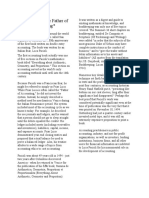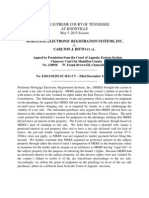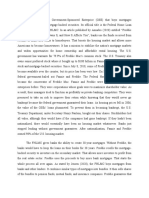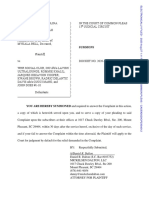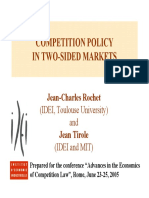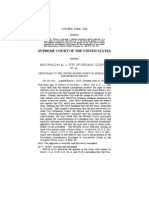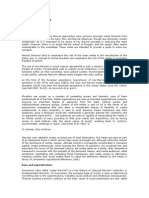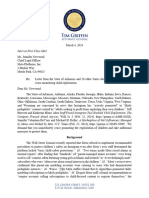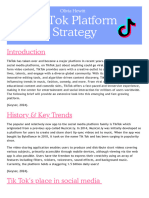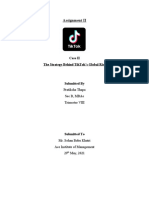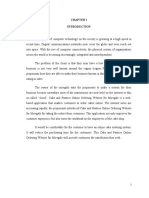Part 1: The System
The Tiktok recommendation algorithm is one that is so highly talked about simply
because of how scarily accurate its recommended content seems to be. According to 26 year old
social media manager Amalie Macgowan, the TikTok app helped to confirm her suspicions of
being bisexual before she had even fully realized her own sexuality. How is it that this
recommendation algorithm is able to get to the core of its users and curate the “perfect” content?
Much of the TikTok algorithm is kept secret but Tiktok does have a page on their website
dedicated to explaining how “How TikTok recommends videos #ForYou.” The basis of
recommendations comes from a variety of factors including user interactions (likes, shares,
comments, accounts followed, content creation, time spent interacting with videos, etc.), video
information (captions, sounds, hashtags, etc.), and device/account settings (language preference,
country setting, device type, etc.). Using metrics such as these helps TikTok to create a unique
content “profile” for each of its users.
From here, a mixture of content-based filtering and collaborative filtering are used to
supply users with new content. Content-based filtering looks for similarities between new videos
and those previously interacted with by a user. Collaborative filterings looks for similarities
between users and makes cross-account recommendations. A combination of classification and
clustering models can be used to group and recommend new content to users. Classification uses
pre-labeled data to train the AI and classify new content whereas clustering looks at patterns in
the data and groups them based on similarities. Once the data is classified and grouped, new
content is ready to be distributed. Once again, metadata is collected from the user and is used to
update their content interests and influence the next batch of videos that will be fed to the
account. This sort of feedback loop ensures that an individual’s ForYou page is always updating,
just as one’s own preferences and thoughts are always “updating”.
This is one of the main aspects that separated TikTok from all other social media
platforms at the time. While all other social media platforms are centered around user interaction
with their social network, TikTok is centered around interaction with reflections of one’s self. A
user’s TikTok feed or “ForYou page” is a reflection of oneself as opposed to other platforms such
as Instagram where a user’s feed is entirely a representation of others. This is also what has
helped TikTok to become such a big success. Many youths rely on TikTok for forming their own
identities and getting feedback on themselves. In this way, TikTok operates as a substitute for
self-reflection because it is much easier to have an algorithm tell us who we are rather than
struggle with that question ourselves.
One main concern surrounding recommendation algorithms is the fact that they are prone
to creating a “filter bubble”. A “filter bubble” is the idea that catering to one’s own interests and
ideals can create an undiverse and unrealistic bubble of content. TikTok states that in order to
prevent this issue from arising, their algorithm does not recommend content already seen before
nor duplicated content. Additionally, the algorithm will occasionally recommend videos that may
not fall in line with a user’s preferences or have a large number of likes/comments in order to
�break up the otherwise homogeneous content stream. That said, the platform also offers users the
option to be “not interested” or “hide content like this”. Theoretically, if a user blocked content
that they did not like enough times, the algorithm would reach a point where somewhat of a filter
bubble is unavoidable.
Part 2: The History
TikTok began its story in 2014 when the application Musical.ly was released. Musical.ly
founder Alex Zhu initially saw the vision for his application as being an educational platform
where educators could post short videos explaining various subjects. He and his team
successfully raised over $250,000 from investors; however, the idea was a bust. After launch, the
team realized that content took too long to make and did not attract teens - “...content creation
and consumption needed to be within minutes and seconds, not hours.” In a scramble to use what
was left of the investor’s money, Zhu came up with the idea to combine music, video, and social
network into one application that would appeal to the teen-demographic. By 2015 Musical.ly
had hit #1 in the app store.
In 2016, Chinese company Bytedance launched Douyin - an application for short video
creation and consumption. ByteDance recognized the large interest in short videos at the time
and how competitive the market was. Anyways, they decided to enter the market but “...pursue
perfection” with their product. They performed vast amounts of user research and internal
product research until they identified their four main focuses for the ultimate experience: full
screen/high definition, music, filters, and personalized recommendation. Kelly Zhang, the creator
of Douyin, stated in an interview that the integration of short video with music “...helps the short
video to become more expressive…everyone has a need for music.” This integration helped to
make Douyin more attractive to “young people” who were the target audience.
Douyin achieved much success in China and was released outside of the country at the
end of 2017 under the name TikTok. Only two months later, ByteDance acquired Musical.ly and
a little under a year later merged the Musical.ly user base into TikTok. Following the merger,
Zhu stated that "Combining Musical.ly and TikTok is a natural fit given the shared mission of
both experiences – to create a community where everyone can be a creator."
Musical.ly and Douyin are the two halves that make up the whole of TikTok. Both
applications emphasized early on the importance of music for their target audience and the
importance of keeping users coming back - two things that TikTok does exceptionally well. They
claim that the integration of short video with music allows for more expressive content that is
more engaging and thus, can be more personalized.
Some interesting points of note include that Musical.ly was originally intended to be an
amazing educational app idea and that Douyin was the child of the “Super App Factory'' as
Bytedance is nicknamed. What this means is that when Zhu realized that his original idea was a
bust, his next idea was built off the need to succeed and not the need for more digestible systems
of education. Douyin was created to generate money. In fact, when ByteDance first released
�Douyin in China, they also released another short video app called Huoshan which had a
different target demographic. This shows ByteDance’s ultimate goal of finding the most
promising market and exploiting it.
These two origin stories show that while copious amounts of user research was conducted
in order to get the product just right, the implications of product addiction and ethics could easily
have been ignored. There is always a fine line to walk between growing/maintaining a user base
and avoiding product addiction/over-reliance. But successful products rely on their ability to
grow a user base which directly correlates to addictive products. A quarter of TikTok’s users
range from 10-19 years of age, showing how the app is able to provide young users with more
expressive, engaging, and personally tailored content than seen before. The age of 10 is when the
human brain becomes more craving of peer approval and more susceptible to lack thereof.
TikTok’s personalization capabilities are very desirable but have also opened doors for these very
young users to fall victim to the dangers of social media.
Part 3: The Ethics
The design and history of the TikTok recommendation algorithm construct the foundation
on which the ethical concerns of this algorithm are based. A couple of these concerns have
already been brought up in previous sections of this paper including: creating filter bubbles,
stunting self-reflection, originating from motives of market power (as most things are), and
spurring addiction in youth. Some other greater societal effects of this system will be discussed
in this section including effects on pop culture, consumerism, and overall human behavior.
The recommendation algorithm’s promotion of “trending” content and sounds has created
a whole new sector of pop-culture. TikTok’s reliance on “sounds” has caused the app to have
direct influence on the music industry. Of the 10 Grammy nominations for 2022 Song of the
Year, 7 of them were songs that had garnered millions of videos on the app. Many labels and
artists are known to get groups of TikTok influencers together and sample different music clips
to see what has the most potential to go viral. This shows how the design of the app has created a
system which dictates not only song popularity but even the songs themselves.
Trending content has also caused never seen before bursts of consumerism. Many users will
simply post videos showing their brand new pair of jeans or water bottle, and next thing you
know the product is sold out on all sites. In fact, the hashtag “#TikTokMadeMeBuyIt'' has over
8.4 billion views with over 69% of users aged 18-34 claiming that an influencer influenced their
decision-making.
These phenomena show the system's ability to dictate our real-world spaces via online
interactions. While we as consumers passively get monitored and classified, we may not realize
that with each swipe, like, and comment, our realities and behaviors are changed.
There are also many positives to this system including the potential for content to be very
educational, motivating, and communal. The nature of the recommendation algorithms has
spawned what are called the different “sides” of TikTok. These sides are directly correlated to the
�classifications created during content based filtering stages of the algorithm. A user can be said
to be on a certain “side” of TikTok depending on the content currently on their FYP. Some sides
of TikTok include BookTok, AltTok, Conspiracy TikTok, and many others. These sections of
TikTok have helped to build a sense of community amongst users as people can simply interact
with content that they like and be entered into communities with similar interests.
If we keep going in the direction we’re headed, TikTok will continue to have a hold on
our decision-making, perceptions, time, and self-identity. The more time we spend engaging with
our recommended content, the less time we spend deciding for ourselves what we value, what we
enjoy, how we want to spend our time, and most importantly, who we are. Most social media
seen up until now has led society to become less thoughtful in terms of the external information
we consume. While this is still the case with TikTok, a newer and potentially more important
concern is how the addictive and tempting natures of this algorithm foster a less internally
thoughtful public. Key word internally.
In order to remedy the potential for TikTok to substitute self-reflection, I would propose
that the app implement a platform-wide time limit of how long an individual user can use the app
per week. Additionally, I think it would be useful for TikTok to issue a “quiz” at the end of every
month or so asking users questions about their self-perceptions. These quiz responses would then
be shown side by side with the algorithm-based answers to those same questions to serve as a
reminder to users that one’s For You page does not define them. A third proposal would be for
the platform to organize events for the different sides of TikTok. These groups that exist online
could be brought into the real world and have potential for people to build more tangible
communities.
At its bones, TikTok is a very addicting app that was built with the intention of stealing
user attention. Thus, it is somewhat unfair to argue that users must take action into their own
hands and stop using the app if they want to avoid its negative consequences. Only the engineers
and managers of the company truly have the power to change the implementation of this system
for the better. But these individuals are often money driven and find that the pros outway the
cons of their technology. The responsibility then falls to politicians who must emphasize the
need for company transparency and creation of tools which are not based on addiction.
While it may seem freakishly cool that TikTok is able to “understand” individual users so
well, these understandings are based on users being sorted into boxes of similar interests and fed
content accordingly. The app successfully creates a space for self expression through content
creation while also reducing individuality of thought using content recommendation. What we
may perceive as an algorithm understanding us to our core, is really an algorithm understanding
thousands of people, supposedly identical to us, to our collective core.
� Bibliography
Bhandari, A., and S. Bimo. “TIKTOK AND THE ‘ALGORITHMIZED SELF’: A NEW
MODEL OF ONLINE INTERACTION”. AoIR Selected Papers of Internet Research,
vol. 2020, Oct. 2020, doi:10.5210/spir.v2020i0.11172.
Carson, Biz. “How a Failed Education Startup Turned into Musical.ly, the Most Popular
App You've Probably Never Heard Of.” Business Insider, Business Insider, 28 May
2016, https://www.businessinsider.com/what-is-musically-2016-5.
David, Laura. “For Better or Worse, TikTok Is Driving the Music Industry.” The Brown
Daily Herald, 16 Sept. 2021,
https://www.browndailyherald.com/article/2021/09/for-better-or-worse-tiktok-is-drivi
ng-the-music-industry.
Ma, Rui. “Creator of Douyin / Tiktok: How We Created a Product with a Billion Views a
Day in 18 Months: Part I.” Pandaily, Pandaily, 18 July 2020,
https://pandaily.com/creator-of-douyin-tiktok-how-we-created-a-product-with-a-billi
on-views-a-day-in-18-months-part-i/.
MacGowan, Amalie, et al. “The TikTok Algorithm Knew My Sexuality Better than I Did.”
Repeller, 5 Sept. 2020, https://repeller.com/tiktok-algorithm-bisexual/.
Mage. “How Does Tiktok Use Machine Learning?” DEV Community, DEV Community,
16 Feb. 2022, https://dev.to/mage_ai/how-does-tiktok-use-machine-learning-5b7i.
Matsakis, Louise. “How TikTok's 'for You' Algorithm Actually Works.” Wired, Conde
Nast, 18 June 2020,
https://www.wired.com/story/tiktok-finally-explains-for-you-algorithm-works/.
Montag, Christian et al. “On the Psychology of TikTok Use: A First Glimpse From
Empirical Findings.” Frontiers in public health vol. 9 641673. 16 Mar. 2021,
doi:10.3389/fpubh.2021.641673
Published by L. Ceci, and Apr 28. “U.S. Tiktok Users by Age 2021.” Statista, 28 Apr.
2022, https://www.statista.com/statistics/1095186/tiktok-us-users-age/.
Smith, Ben. “How Tiktok Reads Your Mind.” The New York Times, The New York Times,
6 Dec. 2021,
https://www.nytimes.com/2021/12/05/business/media/tiktok-algorithm.html.
TikTok. “How Tiktok Recommends Videos #ForYou.” Newsroom, TikTok, 16 Aug. 2019,
https://newsroom.tiktok.com/en-us/how-tiktok-recommends-videos-for-you.
�TodayShow. “Song of the Year Grammy Nominees and the Tiktok Trends They Inspired.”
T ODAY.com, TODAY, 11 Mar. 2022,
https://www.today.com/popculture/music/tiktok-trends-inspired-2022-song-year-gra
mmy-nominees-rcna19405.
Whateley, Dan. “How Tiktok Is Changing the Music Industry.” Business Insider, Business
Insider, 29 Apr. 2022,
https://www.businessinsider.com/how-tiktok-is-changing-the-music-industry-marketi
ng-discovery-2021-7.
“Why Tiktok Made Us Buy It.” Psychology Today, Sussex Publishers,
https://www.psychologytoday.com/us/blog/the-savvy-consumer/202201/why-tiktok
-made-us-buy-it.
“Why Young Brains Are Especially Vulnerable to Social Media.” American Psychological
Association, American Psychological Association,
https://www.apa.org/news/apa/2022/social-media-children-teens.
